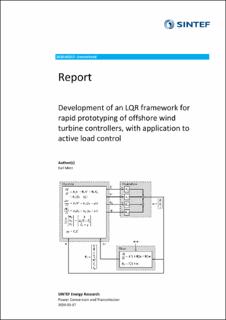| dc.contributor.author | Merz, Karl Otto | |
| dc.date.accessioned | 2020-07-23T10:31:07Z | |
| dc.date.available | 2020-07-23T10:31:07Z | |
| dc.date.created | 2020-06-19T10:49:09Z | |
| dc.date.issued | 2020 | |
| dc.identifier.isbn | 978-82-14-06281-6 | |
| dc.identifier.issn | 1504-9795 | |
| dc.identifier.uri | https://hdl.handle.net/11250/2670020 | |
| dc.description.abstract | A linear quadradic regulator (LQR) framework has been developed for rapid prototyping of offshore wind turbine controllers. This enables the study of tradeoffs between conflicting control objectives, such as maximizing energy production, providing grid services, and reducing loads. The LQR framework is based on a linearized model of an offshore wind turbine, which is of a higher fidelity than typical control-oriented models. Nonetheless, it is shown that a controller can be quickly synthesized using this high-fidelity model. The LQR framework is applied to two case studies involving active load control: directional control of fatigue in monopile foundations, and active damping of wave-driven tower resonance when the turbine is idling. | en_US |
| dc.language.iso | eng | en_US |
| dc.publisher | SINTEF Energi AS | en_US |
| dc.relation.ispartof | SINTEF Rapport | |
| dc.relation.ispartofseries | SINTEF Rapport; | |
| dc.rights | Navngivelse-Ikkekommersiell 4.0 Internasjonal | * |
| dc.rights.uri | http://creativecommons.org/licenses/by-nc/4.0/deed.no | * |
| dc.title | Development of an LQR framework for rapid prototyping of offshore wind turbine controllers, with application to active load | en_US |
| dc.type | Research report | en_US |
| dc.description.version | publishedVersion | en_US |
| dc.rights.holder | SINTEF Energi AS | en_US |
| dc.source.pagenumber | 80 | en_US |
| dc.source.issue | 2020:00257 | en_US |
| dc.identifier.cristin | 1816279 | |
| cristin.ispublished | true | |
| cristin.fulltext | original | |

